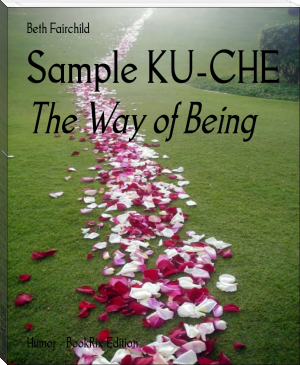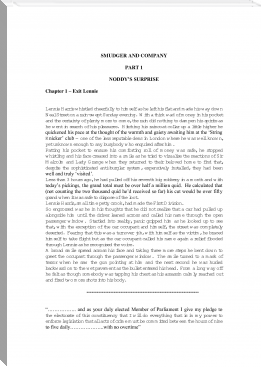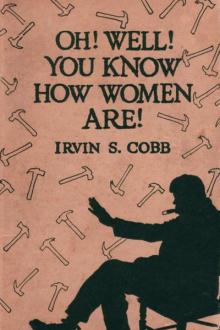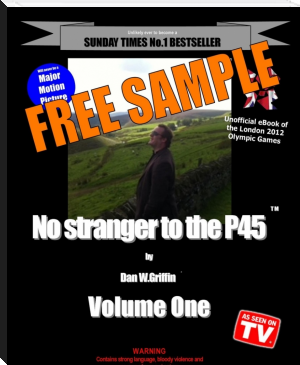Sample KU-CHE by Beth Fairchild (books for 10th graders .TXT) 📕

- Author: Beth Fairchild
Book online «Sample KU-CHE by Beth Fairchild (books for 10th graders .TXT) 📕». Author Beth Fairchild
WARNING
Sending or forwarding an e-mail or electronic message that contains any part of this copyrighted material is an ACT OF PIRACY and is AGAINST THE LAW. While it is true, we no longer hang pirates by their scrawny thieving little necks, it is equally true that intellectual PIRATES will be hunted down and forced to listen to a recording played backwards of an Elvis impersonator singing gospel rap in Esperanto until they confess the error of their way and promise never ever to do it again (no fair crossing your fingers). On the other hand (the one that doesn’t have a hook), a person who contacts the publisher and seeks permission BEFORE (that’s what “prior” means) copying or forwarding any part of this copyrighted material, will not only avoid punishment, but may also receive A MULTITUDE OF BLESSINGS from the Freedom Of The Press Fairies.
NOTICE
This is ENTIRELY a work of FICTION. The Ku-Chē: The Way of Being has never existed in any form other than as pure invention of its author, Beth Fairchild. Other than the author, none of the persons mentioned in the text have ever existed in any dimension of this or any other universe.
DISCLOSURE
When used in accordance with the enclosed instructions (see INTRODUCTION) many readers may experience a temporary measure of relief from rigor mortis religitosis, aura boredomitis, or Post-Dogmatic Stress Disorder (P.D.S.D.),
Some readers may, in addition to or in place of the intended relief, experience certain side effects (acute or chronic) of, but not limited to: cerebral processing arrhythmia (or thought stimulation), systematic neonization of one’s charkas ranging from inspiration to insight, and/or perceptual alteration and realignment.
In some advanced cases of rigor mortis religitosis a pain in the neck or buttocks may develop, or the nose may get bent out of joint, and—in extreme cases—nausea, vomiting and denial may be exhibited. If these occur seek immediate assistance of a competent healthcare professional of your choosing and covered by your insurance plan. Currently the most effective treatment option involves an aggressive removal of hardened objects lodged in the rectum.
Nothing in this book shall be construed as giving medical, legal, financial, astrological advice and/or directions back to the freeway.
This work is a parody; therefore, it should not be taken seriously nor used to create, support, or denigrate any religious, spiritual, or philosophical belief or organization.
Origin & TranslationThe Origin of the Ku-Chē
During the second millennium BCE a small pastoral nomadic tribe, the We-Be, left the central Asian steppes of Kazakhstan and entered into the Emin Valley. The valley was a temperate alcove of grasslands, shrubs and alpine meadows. Streams fed two salt lakes at the valley’s southwestern entrance. Goat-like ibex with their long horns, snow leopards, and wolves roamed the mountains. Saiga antelope with odd snouts grazed the valley and the world’s largest pelicans fished the lakes with relict gulls flying about. The valley encompassed 65,000 square miles, slightly smaller that the state of Washington in the United States. The We-Be called the valley Ban-St’d or Earth Song.
The We-Be lived close to Nature; she was their creator, their provider, their teacher, and their destiny lay in her dust. The community was maintained by a variety of essential roles, all equally valuable. For example, the role of spirit guide, the transmitters of the accumulated wisdom they had observed in nature, was treated with the same respect as proficient hunter or talented weaver. All roles were opened to all ages and all three sexes (female, male, and Tu-N-Won). Interest and ability determined one’s part in the community. Decisions were made by consensus following an open discussion. Their wandering throughout Ban-St’d kept them isolated and independent for centuries—until Bu-Hu or the Time of Sorrow.
2500 years ago was a time of upheaval in China called the Warring States period. A renegade group of outside warriors called D’em found and seized control of the We-Be tribe. Gē-I’jo, the renegade leader, imposed upon all females and Tu-N-Wons the No-Sā order, an absolute ban on all forms of communication. To make a sound meant death. Women gagged themselves so they would not scream during childbirth, and thus live to nurse and care for their children. Women quickly adapted to the new order by using various hand signals and body gestures to replace the oral language. The No-Sā order was expanded to include these adaptations. A simple nod or wink by a female was fatal.
Led by their spirit guide, Yz-Won, the women transformed their oppressor’s domination into a vehicle for meditation and inner liberation. Using their intuitive sense, they developed the ability to be one with each other’s feelings and thoughts. They called their forbidden method the Wa-Ch’a language (the mind sees what the heart feels). Yz-Won synthesized their traditional oral teachings with the additional insights gained from their meditation into a new teaching: the Ku-Chē (The Way of Being).
The Mu-Chē (Being in the Way) was the Wa-Ch’anese term for the male-dominated tribal religion that had replaced their oral traditions. In the second century because of a series of military blunders, the We-Be tribe was wiped out. With the destruction of the tribe and their Wa-Ch’anese women and Tu-N-Wons, the Ku-Chē was lost.
Translation
The exact nature of telepathic and related forms of communication (such as Wa-Ch’a language) is a highly classified national security secret. The government has temporally suspended the development of thought-controlled weapon systems due to the problem that they can only be used by those in control of their thoughts. Momentary lapses can have disastrous results, like a sudden urge to kill a supervisor, or a bout of depression. After all, weapons are designed for war, not murder or suicide. This is the real reason behind the often stated official policy that, “Weapons of Mass Destruction must never come under the control of a madman.”
The other and insurmountable problem with thought controlled weapons is that those who truly are in control of their thoughts are at peace with themselves and the world around them. Triggers without willing fingers or minds are of no use to the military.
All of this is to say why I am unable to explain the translation of the Ku-Chē in any detail. However, there are a few general things I can say about the translation presented in this book.
First, the mental word pictures and their heart-felt meanings in the Wa-Ch’a language are translated into a phonic equivalent of contemporary American English.
Second, the 17 paragraphs and their 81 sentences that comprise the translated text are numbered as chapter and verse for reference and study. For example, Ku-Chē 10.3 is the tenth paragraph and the third sentence, which in this case is, “What is our true being?” The Ku-Chē may also be abbreviated in citations as KC.
Third, below each Ku-Chēan verse is my own commentary.
One final plea: please read the Notice and the Disclosure in the front of the book. They contain answers to many questions and concerns that may arise.
11.1
The Way of Being
should never
be confused with
Being in the Way.
Commentary
To some this verse seems to say, “Hey, whatever you do—don’t mix us up with them.” Others hear, “Whoa, our way is wa-a-ay cooler.” To me it juxtaposes two very different approaches to life.
The first views itself as a part of and connected to every living being in nature. Therefore, as a part of nature it seeks to live in harmony with nature and accepts life as it naturally unfolds. The best way to do something is to let nature run its course.
The second, and most commonly held view, is to see ourselves as separate and superior to all worldly creatures. We set out to achieve our own purposes, using our own abilities and commandeering whatever natural resources that we need. In determining to make a difference in the world, we make the world different—not better, but different. The unforeseen consequence of trying to change things we don’t fully understand is to create disharmony, within and without ourselves. Our intention and efforts to control cause our lives to become increasingly chaotic. We truly are being in the way of our own being.
1.2
The Way of Being (Ku-Chē) is,
in part,like a flood of cosmic essence
flowing in, around, and through
all things.
Commentary
Wa-Zit, the Ku-Chē symbol
The Wa-Zit was created when a piece red of yarn fell unto white sand in the shape shown on above. What the shape represents depends upon the viewer. Some see an Asian happy face, a frog face, an open vessel or a handle. Much as with ink blots, what one sees reveals more about one’s own self than about the Wa-Zit.
My understanding is that the red line represents the visible and the white the invisible that flows in, around, and through all things. It is what we don’t see that defines what we do see, just as our perception of color is the reflection of unabsorbed light.
1.3
Thus,
all things
are alive
and connected.
Commentary
Symbiosis, the interdependence of living organisms, is one of nature’s essential ways. The dance of breath between flora and fauna is but one example. We breathe in what plants have breathed out and plants consume our exhaled breath. Breath is bound up in our notions of life. A baby’s first cry brings joy and relief. Grandmother’s last breath gives birth to the new life that we call death. The exchange of breaths is an act of intimacy—emotionally as a kiss, and spiritually as the intermingling of our souls. Intimacy increases our understanding of one another. We begin to feel that we are each a part of the other’s universe.
1.4
No matter
how the counting
of all things is done;
numerable and
innumerable,
seen and unseen,
the grand total is
always the same—
one.
Commentary
The Ku-Chean observations of Nature taught them that the appearance of separateness was an illusion. There are many different parts performing different functions. Although different, the parts are not separate and cannot exist without the others. In a way our eyes are like those of bees; we see many when there is only one.
THE LIVING TREE
An emerald leaf flutters in the zephyr’s breath
sparkling beneath the Sun
whose





Comments (0)